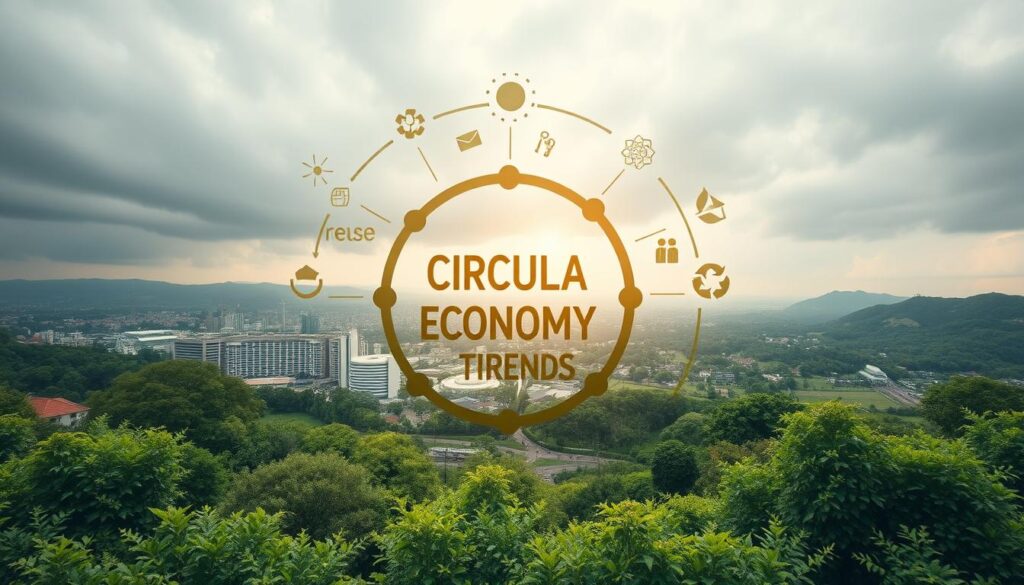Anúncios
sustainability trends 2025 — can a single year really shift how your company handles climate risk and capital? This question matters because decisions you make now will shape costs, access to finance, and operational resilience.
The 2020s are a decisive decade. Global emissions hit record highs in 2024, yet new rules, tech advances, and corporate pressure open real avenues to act.
In 2025 you’ll see policy milestones, moving capital markets, and maturing technology like CCS hubs and green hydrogen plants. These changes affect reporting, financing, and supply chains — and they create both opportunities and challenges for your business.
Read on to get a clear, practical roadmap that links market realities to strategy. Use these insights to set goals, weigh risks, and decide when to seek expert advice for major moves.
Introduction: Why sustainability trends 2025 matter for your strategy
sustainability trends 2025 shift how companies frame climate risk and capital allocation this year. That matters because new rules, legal milestones, and capital goals will change how you plan operations and financing.
Anúncios
From decisive decade to decisive decisions: record emissions in 2024 plus geopolitical strains mean policy timelines can tighten or slip. ESRS becomes mandatory for many large firms, and an ICJ advisory opinion on climate obligations is due — all of which shape legal and reporting risk.
What’s different this year is the mix of policy, capital, and tech maturity. NCQG targets and the Loss and Damage Fund influence finance flows. At the same time, CCS hubs and industrial-scale green hydrogen are moving from planning into construction, and rising electricity demand affects your energy exposure.
Practical next steps: focus on material solutions for your operations, shore up data and assurance to build investor trust, and treat this guidance as input — not a guarantee. Complex moves deserve professional advice tailored to your business and industries.
Anúncios
From decisive decade to decisive decisions: the 2025 inflection
- New reporting rules raise expectations for data and management.
- Legal and finance milestones change what investors and boards expect.
- Technology shifts create fresh operational choices for energy and supply chains.
What’s different this year: policy shifts, capital flows, and tech maturity
Policy uncertainty in the U.S. and global conflicts can shift timelines and costs. Meanwhile, markets are pushing for assured integrated reporting to boost trust and reduce investor uncertainty.
Policy and geopolitics: Navigating uncertainty while keeping climate goals on track
Policy shifts and geopolitical shocks will shape how you plan climate action this year. You need clear decision points that match changing risks and opportunities.
The U.S. outlook: Paris, IRA exposure, and the energy mix
Assess U.S. scenarios: a possible Paris exit, IRA rollback, or continued investment in clean projects. Look at permitting reforms that could speed or delay your builds.
Europe and the UK signals
ESRS is mandatory for many large firms. The UK backs hydrogen but faces budget limits. Expect fiscal pressure to affect incentives and adoption.
Global governance and milestones
The ICJ advisory opinion and COP30 may clarify obligations — or add uncertainty. Conflicts are straining cooperation and funding for developing economies.
- Practical steps: map policy scenarios into a risk register and set decision gates.
- Energy trade-offs: factor LNG’s near-term role versus renewables and nuclear when planning capacity.
- Trust-building: improve disclosures and engage with governments and standard-setters to lower reputational risks.
Climate finance in motion: Where capital is coming from—and where it needs to go
Investors are re-rating projects as new targets and tax rules clarify risk and reward. That shift affects how you plan deals and choose partners for green projects.
The NCQG signal matters: the $300B-by-2035 target directs public and private capital toward developing economies. Expect more engagement from multilateral banks and export credit agencies as they align with this goal.
The Loss and Damage Fund becomes operational in 2025, but it sits outside NCQG. That raises questions about long-term funding certainty and how resilience projects will be prioritized by governments and donors.
Private and tax-driven channels
Private nature and transition finance is growing via green bonds and high-quality credits, yet scale still lags need. Look for rigorous vetting of integrity and additionality to avoid reputational risks.
In the U.S., tax credit transfer markets and hybrid tax equity structures are maturing. Standardized terms can speed execution, but strong project economics remain essential.
- What to map: methane, CCS hubs, hydrogen, and electrification — each has different co-investor profiles and risk tolerances.
- Data you’ll need: lifecycle emissions, nature impacts, and social co-benefits for due diligence and investor alignment.
- Reality check: large transactions (for example, big credit facilities and major M&A) show market depth, but not every project will access the same terms.
Corporate reporting shifts: Double materiality, assurance, and data you can trust
Clearer rules on disclosure mean your reporting must link impacts and financial outcomes. ESRS becomes compulsory for large companies from the 2025 financial year, so you need practical next steps now.
What double materiality looks like in practice:
ESRS goes live for 2025 filings: What double materiality means for you
Double materiality asks you to report both your impacts on climate and nature and how those issues affect your finances. For many companies this means adding value-chain metrics and governance notes to annual filings.
Voluntary adoption: CSRD, ISSB, and SEC elements driving market trust
Use the Forrester/Workiva data to benchmark decisions: 68% of companies not required to adopt CSRD plan partial adoption, 61% plan partial ISSB adoption, and 73% had planned to implement SEC elements. Partial adoption can boost investor confidence when tailored to your goals.
Assured integrated reporting: Building confidence amid data collection challenges
Survey signals show 76% view assured integrated reporting as crucial, while 57% struggle to collect trustworthy data and 91% say current tools fall short.
- Checklist for 2025 filings: map scope, assign owners, gather value-chain data, and document controls.
- Assurance pathway: choose limited or reasonable assurance based on risk and investor needs.
- Team actions: align finance and sustainability, set KPIs, and avoid overclaiming in narratives.
“76% say communicating sustainable value is critical to investor relations.”
Next step: treat these practices as part of your management approach and consult qualified assurance and legal experts before finalizing filings.
sustainability trends 2025: AI’s promise and footprint in climate and nature
AI is reshaping how you manage power grids, fleets, and habitat monitoring, but it also brings new environmental costs. You can get faster decisions and fewer bottlenecks. Yet training and running large models uses notable electricity and cooling water.
Where AI can help: Grid optimization, supply chains, and conservation monitoring
High-value applications are clear and practical. AI can balance load on the grid, optimize routing for transport, and flag threats in conservation imagery. These technologies speed decisions and improve operational efficiency.
Managing impacts: Energy, water, critical minerals, and the rebound effect
You should quantify AI’s footprint. Measure electricity use, water for cooling, and critical minerals in hardware. Some firms offset this with contracted clean power for data centers.
- Identify priority solutions that cut bottlenecks—grid balancing, routing, and analytics.
- Track drivers of footprint: energy intensity, water use, and mineral demand.
- Assess efficiency gains against rebound risks so productivity does not increase overall resource use.
Practical next steps: set governance for model choice and data quality, define metrics (energy per inference, water intensity, emissions per task), and pilot low-resource models before scaling.
Consult technical and environmental experts to weigh trade-offs and design responsible deployment. That way you capture the AI change without unintended harms.
Energy transition tech in 2025: From planning to projects
Key low-carbon technologies are moving from feasibility studies to signed contracts and cranes on site. That shift alters timing, procurement, and risk for your projects across industries.

Carbon capture and storage: Hubs enter construction
In Northwest Europe, CCS hubs are advancing into construction. You’ll track milestones that affect transport access, storage capacity, and offtake contract terms.
Implication: secure cross-border permits early and tie your procurement to confirmed storage allocations to lower delivery risk.
Green hydrogen milestones: First industrial plants
Europe’s first industrial-scale green hydrogen plants are coming online. Electrolyzer costs, contracted power sources, and credible offtakers determine bankability.
Practical action: require firm power supply agreements and staged CAPEX release tied to performance tests.
LNG, rising power demand, and renewables
Data center growth is pushing discussions on LNG as a reliability option while renewables scale to meet rising electricity demand.
Plan procurement that blends renewables, storage, and short-term fuel to manage price swings and interconnection delays.
- Map CCS construction dates to your transport and storage contracts.
- Assess electrolyzer suppliers, power sourcing, and offtaker credit for hydrogen projects.
- Design renewable-plus-storage tenders to smooth volatility and grid constraints.
- Pilot carbon removal with clear MRV and realistic scale expectations.
- Layer efficiency and demand-management measures to cut operating costs and emissions.
“Investments in carbon removal pilots are increasing, but scale and MRV remain the constraints.”
Sequence initiatives by sector—industrial heat, chemicals, and heavy transport have different timelines—so you can align investments and minimize stranded asset risk.
Strategic playbook for U.S. businesses: Practical moves for the year ahead
To act effectively this year, U.S. companies need a focused playbook that ties operations to capital choices. Use clear, staged steps so your business can move when permits, tax rules, or markets shift. Work with advisors; these are options to consider, not guarantees.
Operations and supply chains
Operational fixes cut risk and create optionality for funding. Start with an internal carbon price to guide procurement, CAPEX, and product choices. Keep the price pragmatic so investors see signal without overcommitment.
Strengthen procurement with supplier scorecards, nature risk screens, and methane performance criteria for oil, gas, and agriculture. Scale methane cuts with LDAR, continuous measurement, and performance contracts.
Capital and investors
Align capital plans to federal and state incentives. Consider tax equity, transferability, and hybrid structures to improve project economics. Large ITC/PTC deals show market depth but require careful structuring.
- Communicate value: build investor-ready narratives that link strategy, risks, and measurable progress.
- Permit planning: sequence community engagement and interconnection early to avoid delays.
- Solutions stacking: prioritize efficiency, electrification, renewables, CCS, and offsets based on materiality.
“Embed clear KPIs and cross-functional ownership to keep transition initiatives on track.”
For a compact primer on corporate priorities, see corporate sustainability priorities. Treat these moves as part of your management routine and consult legal and financial advisors before major commitments.
Conclusion
You face a year where real projects and new rules collide with stubborn emissions and uneven finance. Use the material shifts—reporting mandates, project milestones, and market signals—to set clear priorities that match your risk appetite.
Plan in stages: balance near-term execution with longer-term transformation. Pick one or two high-impact moves now, fund them well, and build simple metrics for emissions and resource use.
Be transparent about goals and efforts. Seek legal, technical, and financial advice when stakes are high so your choices fit your context and scale.
Treat these sustainability trends 2025 as a practical roadmap: act deliberately, learn from experience, and adjust as markets and policy evolve.



